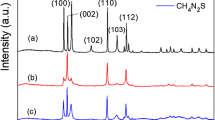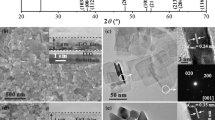Abstract
It has been widely reported that, for faceted nanocrystals, the two adjacent facets with different band levels contribute to promoted charge separation, and provide active sites for photocatalytic reduction and oxidation reaction, respectively. In such cases, only one family of facets can be used for photocatalytic hydrogen evolution. Herein, by using SrTiO3 nanocrystals enclosed by {023} and {001} facets as a model photocatalyst, this paper proposed a strategy to achieve the full-facets-utilization of the nanocrystals for photocatalytic hydrogen via chemically depositing Pt nanoparticles on all facets. The photo-deposition experiment of CdS provided direct evidence to demonstrate that the {023} facets which were responsible for photooxidation reaction can be function-reversed for photocatalytic hydrogen evolution after depositing Pt nanoparticles, together with the {001} facets. Thus, the full-facets-utilization led to a much-improved activity for photocatalytic hydrogen, in contrast to those SrTiO3 nanocrystals with only {001} facets deposited by Pt nanoparticles via a photo-deposition method.
Similar content being viewed by others
References
Samanta B, Morales-García Á, Illas F, et al. Challenges of modeling nanostructured materials for photocatalytic water splitting. Chemical Society Reviews, 2022, 51(9): 3794–3818
Zhu Q, Xu Q, Du M, et al. Recent progress of metal sulfide photocatalysts for solar energy conversion. Advanced Materials, 2022, 34(45): 2202929
Feng C, Wu Z P, Huang K W, et al. Surface modification of 2D photocatalysts for solar energy conversion. Advanced Materials, 2022, 34(23): 2200180
Tao X, Zhao Y, Wang S, et al. Recent advances and perspectives for solar-driven water splitting using particulate photocatalysts. Chemical Society Reviews, 2022, 51(9): 3561–3608
Xue Z H, Luan D, Zhang H, et al. Single-atom catalysts for photocatalytic energy conversion. Joule, 2022, 6(1): 92–133
Hisatomi T, Domen K. Reaction systems for solar hydrogen production via water splitting with particulate semiconductor photocatalysts. Nature Catalysis, 2019, 2(5): 387–399
Wang Z, Hisatomi T, Li R, et al. Efficiency accreditation and testing protocols for particulate photocatalysts toward solar fuel production. Joule, 2021, 5(2): 344–359
Ismael M. Environmental remediation and sustainable energy generation via photocatalytic technology using rare earth metals modified g-C3N4: A review. Journal of Alloys and Compounds, 2023, 931: 167469
Zhang Y, Xu J, Zhou J, et al. Metal-organic framework-derived multifunctional photocatalysts. Chinese Journal of Catalysis, 2022, 43(4): 971–1000
Zhou C, Wang T, Li D, et al. Flux-assisted low temperature synthesis of SnNb2O6 nanoplates with enhanced visible light driven photocatalytic H2-production. Journal of Physical Chemistry C, 2021, 125(42): 23219–23225
Wang J, Wang J, Shi R, et al. Facile fabrication of N-doped K2Nb2O6 nanocrystals with defective pyrochlore structure for improved visible-light photocatalytic hydrogen production. Small Structures, 2023, 4(1): 2200105
Guo L, Chen Y, Su J, et al. Obstacles of solar-powered photocatalytic water splitting for hydrogen production: A perspective from energy flow and mass flow. Energy, 2019, 172: 1079–1086
Tang C, Cheng M, Lai C, et al. Recent progress in the applications of non-metal modified graphitic carbon nitride in photocatalysis. Coordination Chemistry Reviews, 2023, 474: 214846
Wang N, Cheng L, Liao Y, et al. Effect of functional group modifications on the photocatalytic performance of g-C3N4. Small, 2023, 19(27): 2300109
Tang Z R, Han B, Han C, et al. One dimensional CdS based materials for artificial photoredox reactions. Journal of Materials Chemistry. A, Materials for Energy and Sustainability, 2017, 5(6): 2387–2410
Chen R, Chen J, Che H, et al. Atomically dispersed main group magnesium on cadmium sulfide as the active site for promoting photocatalytic hydrogen evolution catalysis. Chinese Journal of Structural Chemistry, 2022, 41: 2201014–2201018
Yuan L, Han C, Yang M Q, et al. Photocatalytic water splitting for solar hydrogen generation: Fundamentals and recent advancements. International Reviews in Physical Chemistry, 2016, 35(1): 1–36
Li S H, Zhang N, Xie X, et al. Stress-transfer-induced in situ formation of ultrathin nickel phosphide nanosheets for efficient hydrogen evolution. Angewandte Chemie International Edition, 2018, 57(40): 13082–13085
Moon H S, Hsiao K C, Wu M C, et al. Spatial separation of cocatalysts on Z-scheme organic/inorganic heterostructure hollow spheres for enhanced photocatalytic H2 evolution and in-depth analysis of the charge-transfer mechanism. Advanced Materials, 2023, 35(4): 2200172
Zhang L, Zhang J, Yu H, et al. Emerging S-scheme photocatalyst. Advanced Materials, 2022, 34(11): 2107668
Kosco J, Gonzalez-Carrero S, Howells C T, et al. Generation of long-lived charges in organic semiconductor heterojunction nanoparticles for efficient photocatalytic hydrogen evolution. Nature Energy, 2022, 7(4): 340–351
Shen R, Zhang L, Li N, et al. W-N bonds precisely boost Z-scheme interfacial charge transfer in g-C3N4/WO3 heterojunctions for enhanced photocatalytic H2 evolution. ACS Catalysis, 2022, 12(16): 9994–10003
Sun S, Gao R, Liu X, et al. Engineering interfacial band bending over bismuth vanadate/carbon nitride by work function regulation for efficient solar-driven water splitting. Science Bulletin, 2022, 67(4): 389–397
Cai H, Wang B, Xiong L, et al. Orienting the charge transfer path of type-II heterojunction for photocatalytic hydrogen evolution. Applied Catalysis B: Environmental, 2019, 256: 117853
Zhang T, Meng F, Cheng Y, et al. Z-scheme transition metal bridge of Co9S8/Cd/CdS tubular heterostructure for enhanced photocatalytic hydrogen evolution. Applied Catalysis B: Environmental, 2021, 286: 119853
Liu D, Zhang J, Li C, et al. In-situ fabrication of atomic charge transferring path for constructing heterojunction photocatalysts with hierarchical structure. Applied Catalysis B: Environmental, 2019, 248: 459–465
Wei D, Tan Y, Wang Y, et al. Function-switchable metal/semiconductor junction enables efficient photocatalytic overall water splitting with selective water oxidation products. Science Bulletin, 2020, 65(16): 1389–1395
Hu J, Chen D, Mo Z, et al. Z-scheme 2D/2D heterojunction of black phosphorus/monolayer Bi2WO6 nanosheets with enhanced photocatalytic activities. Angewandte Chemie International Edition, 2019, 58(7): 2073–2077
Faraji M, Yousefi M, Yousefzadeh S, et al. Two-dimensional materials in semiconductor photoelectrocatalytic systems for water splitting. Energy & Environmental Science, 2019, 12(1): 59–95
Li J, Wu C, Li J, et al. 1D/2D TiO2/ZnIn2S4 S-scheme heterojunction photocatalyst for efficient hydrogen evolution. Chinese Journal of Catalysis, 2022, 43(2): 339–349
Li H, Sun B, Gao T, et al. Ti3C2 MXene co-catalyst assembled with mesoporous TiO2 for boosting photocatalytic activity of methyl orange degradation and hydrogen production. Chinese Journal of Catalysis, 2022, 43(2): 461–471
Yan T, Zhang X, Liu H, et al. CeO2 particles anchored to Ni2P nanoplate for efficient photocatalytic hydrogen evolution. Chinese Journal of Structural Chemistry, 2022, 41: 2201047–2201053
Yang J, Wu X, Mei Z, et al. CVD assisted synthesis of macro/mesoporous TiO2/g-C3N4 S-scheme heterojunction for enhanced photocatalytic hydrogen evolution. Advanced Sustainable Systems, 2022, 6(8): 2200056
Mei Z, Wang G, Yan S, Wang J. Rapid microwave-assisted synthesis of 2D/1D ZnIn2S4/TiO2 S-scheme heterojunction for catalyzing photocatalytic hydrogen evolution. Acta Physico-Chimica Sinica, 2021, 37(6): 2009097 (in Chinese)
Wang P, Li H, Cao Y, et al. Carboxyl-functionalized graphene for highly efficient H2-evolution activity of TiO2 photocatalyst. Acta Physico-Chimica Sinica, 2021, 37(6): 2008047 (in Chinese)
Han B, Liu S, Zhang N, et al. One-dimensional CdS@MoS2 core-shell nanowires for boosted photocatalytic hydrogen evolution under visible light. Applied Catalysis B: Environmental, 2017, 202: 298–304
Yang M Q, Han C, Xu Y J. Insight into the effect of highly dispersed MoS2 versus layer-structured MoS2 on the photocorrosion and photoactivity of CdS in graphene-CdS-MoS2 composites. Journal of Physical Chemistry C, 2015, 119(49): 27234–27246
Li Y H, Qi M Y, Li J Y, et al. Noble metal free CdS@CuS-NixP hybrid with modulated charge transfer for enhanced photocatalytic performance. Applied Catalysis B: Environmental, 2019, 257: 117934
Lu K Q, Qi M Y, Tang Z R, et al. Earth-abundant MoS2 and cobalt phosphate dual cocatalysts on 1D CdS nanowires for boosting photocatalytic hydrogen production. Langmuir, 2019, 35(34): 11056–11065
Wang Z, Wang L, Cheng B, et al. Photocatalytic H2 evolution coupled with furfuralcohol oxidation over Pt-modified ZnCdS solid solution. Small Methods, 2021, 5(11): 2100979
Adenle A, Zhou H, Tao X, et al. Crystal facet modulation of Bi2WO6 microplates for spatial charge separation and inhibiting reverse reaction. Chemical Communications, 2021, 57(88): 11637–11640
Bai Y, Zhou Y, Zhang J, et al. Homophase junction for promoting spatial charge separation in photocatalytic water splitting. ACS Catalysis, 2019, 9(4): 3242–3252
Scanlon D O, Dunnill C W, Buckeridge J, et al. Band alignment of rutile and anatase TiO2. Nature Materials, 2013, 12(9): 798–801
Liu M, Jing D, Zhou Z, et al. Twin-induced one-dimensional homojunctions yield high quantum efficiency for solar hydrogen generation. Nature Communications, 2013, 4(1): 2278
Liu M, Wang L, (Max) Lu G, et al. Twins in Cd1−xZnxS solid solution: Highly efficient photocatalyst for hydrogen generation from water. Energy & Environmental Science, 2011, 4: 1372–1378
Naldoni A, Altomare M, Zoppellaro G, et al. Photocatalysis with reduced TiO2: From black TiO2 to cocatalyst-free hydrogen production. ACS Catalysis, 2019, 9(1): 345–364
Wang B, Shen S, Mao S S. Black TiO2 for solar hydrogen conversion. Journal of Materiomics, 2017, 3(2): 96–111
Chen X, Liu L, Yu P Y, et al. Increasing solar absorption for photocatalysis with black hydrogenated titanium dioxide nanocrystals. Science, 2011, 331(6018): 746–750
Wang B, Shen S, Guo L. Surface reconstruction of facet-functionalized SrTiO3 nanocrystals for photocatalytic hydrogen evolution. ChemCatChem, 2016, 8(4): 798–804
Takata T, Jiang J, Sakata Y, et al. Photocatalytic water splitting with a quantum efficiency of almost unity. Nature, 2020, 581(7809): 411–414
Ohno T, Sarukawa K, Matsumura M. Crystal faces of rutile and anatase TiO2 particles and their roles in photocatalytic reactions. New Journal of Chemistry, 2002, 26(9): 1167–1170
Tachikawa T, Yamashita S, Majima T. Evidence for crystal-face-dependent TiO2 photocatalysis from single-molecule imaging and kinetic analysis. Journal of the American Chemical Society, 2011, 133(18): 7197–7204
Li R, Zhang F, Wang D, et al. Spatial separation of photogenerated electrons and holes among {010} and {110} crystal facets of BiVO4. Nature Communications, 2013, 4(1): 1432
Li R, Han H, Zhang F, et al. Highly efficient photocatalysts constructed by rational assembly of dual-cocatalysts separately on different facets of BiVO4. Energy & Environmental Science, 2014, 7(4): 1369–1376
Zhu J, Fan F, Chen R, et al. Direct imaging of highly anisotropic photogenerated charge separations on different facets of a single BiVO4 photocatalyst. Angewandte Chemie International Edition, 2015, 54(31): 9111–9114
Li N, Liu M, Zhou Z, et al. Charge separation in facet-engineered chalcogenide photocatalyst: A selective photocorrosion approach. Nanoscale, 2014, 6(16): 9695–9702
Wang B, Liu M, Zhou Z, et al. Surface activation of faceted photocatalyst: When metal cocatalyst determines the nature of the facets. Advanced Science, 2015, 2(11): 1500153
Wang B, Shen S, Guo L. SrTiO3 single crystals enclosed with high-indexed {023} facets and {001} facets for photocatalytic hydrogen and oxygen evolution. Applied Catalysis B: Environmental, 2015, 166–167: 320–326
Acknowledgements
This work was financially supported by the National Natural Science Foundation of China (Grant Nos. 52225606 and 51888103), the Fundamental Research Funds for the Central Universities, China, and the Youth Innovation Team of Shaanxi Universities, China.
Author information
Authors and Affiliations
Corresponding author
Ethics declarations
Competing interests The authors declare that they have no competing interests.
Supporting information
Rights and permissions
About this article
Cite this article
Wang, B., An, B., Li, X. et al. Function-reversible facets enabling SrTiO3 nanocrystals for improved photocatalytic hydrogen evolution. Front. Energy 18, 101–109 (2024). https://doi.org/10.1007/s11708-023-0894-4
Received:
Accepted:
Published:
Issue Date:
DOI: https://doi.org/10.1007/s11708-023-0894-4




